Scotland's Carers
This report brings together statistical analysis and research on caring. The report is intended to provide a useful source of information for carer's organisations, policy makers, local authorities and anyone who is a carer or knows someone who is a carer.
This document is part of a collection
5. Chapter 5: Where Do Carers Live?
- 9.3% of the Scottish population as a whole identified themselves as being a carer in Scotland's Census 2011
- Proportion of carers ranges from 7% of population in Aberdeen City to 11% in East Dunbartonshire
- Highest overall rates of carers are in council areas in the West of Scotland
5.1. Introduction
Carers are found across Scotland, and in this section we give a picture of the proportion in each Local Authority area.
5.2. Carers by local authority area
Figure 42: Percentage of people who provide unpaid care, by Local Authority, 2011
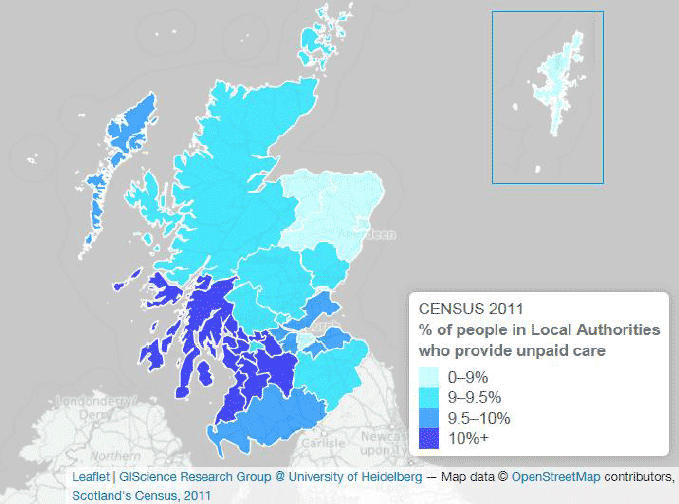
Interactive map available at: https://c5aa50a6216d1f7da7c1ec1cec7d1391cee7df41.googledrive.com/host/0B_cx2PbyKhK6cllJMkIzbmViTjQ/LACMap_2011carers.html
Source: Scotland's 2011 Census
Scotland's 2011 Census shows that 9.3% of the Scottish population as a whole identified themselves as being a carer but this varies quite considerably across Scotland.
The highest rates of caring tend to be in council areas towards the west coast of Scotland. East and West Dunbartonshire show the highest rates at nearly 11% of the population. Aberdeen City has the lowest rate at 7%.
Figure 43: Percentage of population providing care , Scotland 2011
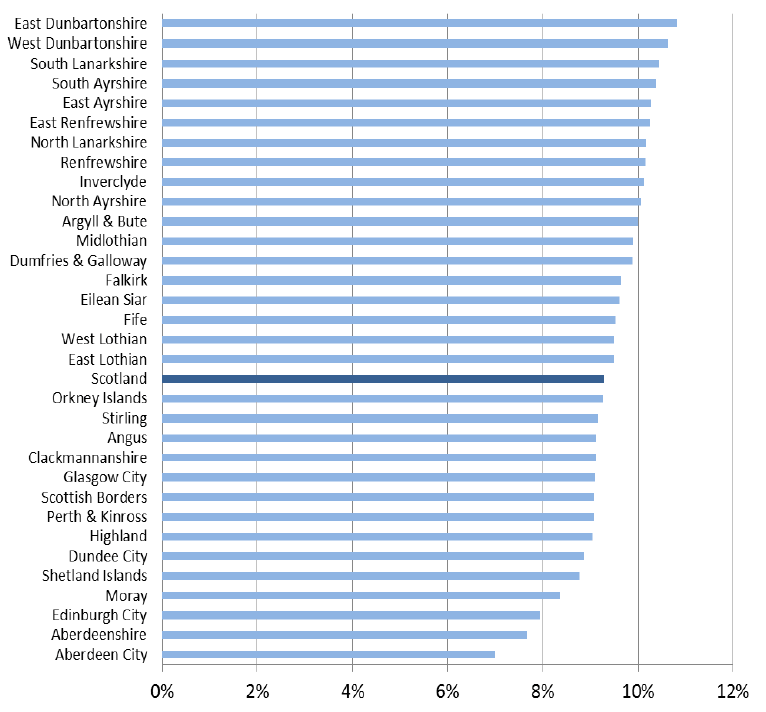
Source: Scotland's 2011 Census
However looking at the hours of care provided in different local authorities in Scotland tells a different story. Looking at councils according to the proportion of carers who say that they care for 35 hours a week or more (the rate at which Carer's allowance can be claimed) and representing a significant amount of caring over the course of a week (equivalent to carrying out a full-time job):
Figure 44: % of people who provide 35 or more hours of care per week, by Local Authority, 2011
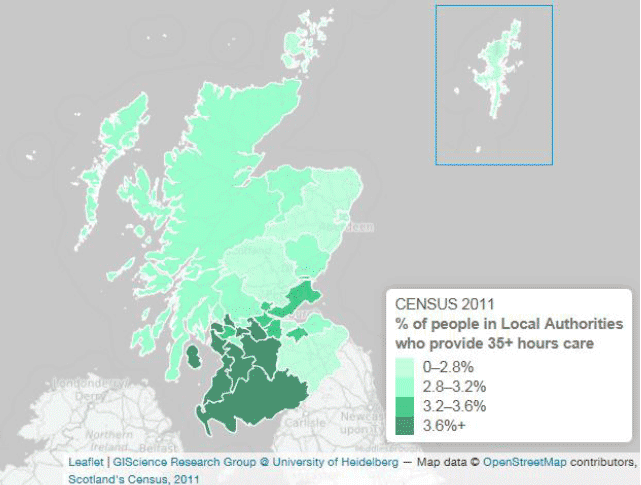
Interactive map available at: https://c5aa50a6216d1f7da7c1ec1cec7d1391cee7df41.googledrive.com/host/0B_cx2PbyKhK6cllJMkIzbmViTjQ/LACMap_2011carers_35+.html
Source: Scotland's 2011 Census
Again the highest rates appear to be in the west of Scotland but East Dunbartonshire which has the highest rate overall of carers is now in the second half of the table so has a below average rate of carers who care for 35 hours a week or more. East Renfrewshire is similar; both these areas have high levels of caring but not high levels of intensive caring.
Conversely, Glasgow and Dundee are both in the bottom half of the table showing the overall rate of caring but have moved to the top half of the table for carers who care for 35 hours a week or more so while these two areas don't have high levels of overall caring they do have a higher proportion of carers caring for 35 hours a week or more. This could be linked to the deprivation analysis looked at in Chapter 1.
Figure 45: Percentage of population providing care, by intensity of caring, Scotland 2011
(Ranked according to percentage of population providing 35 hours of care each week)
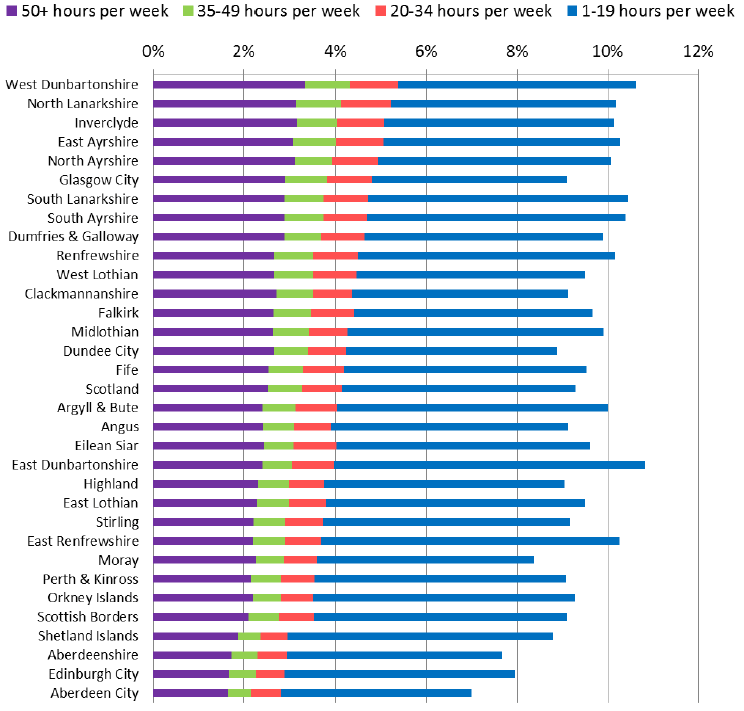
Source: Scotland's 2011 Census
This analysis shows that the prevalence of caring varies widely from one local authority to another, both in terms of overall numbers of carers and those where high levels of caring are involved. The reasons for this are likely to be complex and will be heavily influenced by the socio-demographic compositions of the populations.
5.3. Carers in urban and rural areas
Scotland's 2011 Census allows us to look at carers and where they live in Scotland categorised according to the urban / rural classification. http://www.gov.scot/Topics/Statistics/About/Methodology/UrbanRuralClassification
UR1 - Large Urban Areas - Settlements of 125,000 or more people.
UR2 - Other Urban Areas
UR3 - Accessible small Towns
UR4 - Remote Small Towns
UR5 - Very Remote Small Towns
UR6 - Accessible Rural
UR7 - Remote Rural
UR8 - Very Remote Rural
Figure 46: Proportion of people providing care in each urban / rural area, 2011
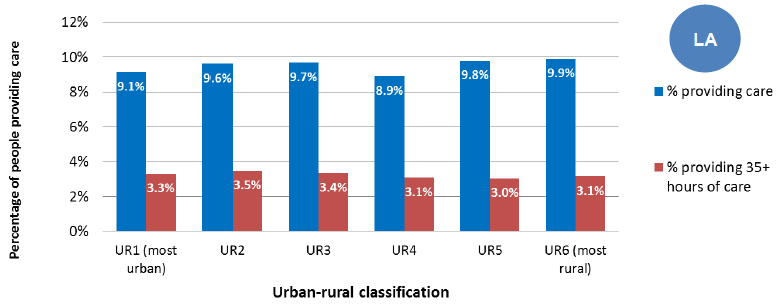
Source: Scotland's 2011 Census
Overall the proportion of people providing care in each urban / rural classification varies from 8.9% in accessible small towns to 9.9% in the very remote rural areas. The proportion of people providing 35 hours of care a week or more varies from 3.0% in very remote small towns to 3.5% in other urban areas. Again the reasons for this are likely to be complex and will be influenced by the socio-demographic composition of the populations as well as the availability of local services.
Contact
Email: Steven Gillespie
There is a problem
Thanks for your feedback
